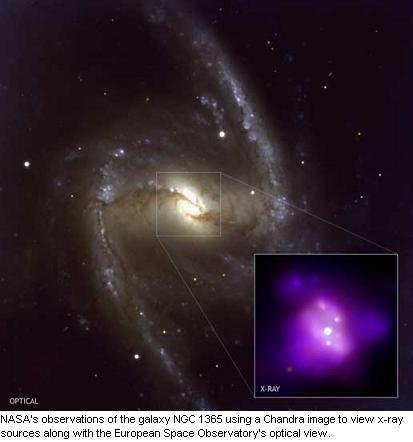|
Did you know?
Cygnus X-1 is one of the first black holes to be discovered and it is located approximately 8000 light years away. It is also 5-10 times the mass of the sun and a radius of 15-30km. 37
|
Solely from its definition one may start to wonder, how do we detect black holes if we cannot see them? Although there is no irrefutable proof of black holes, using massive telescopes able to detect electromagnetic radiation beyond just the visible spectrum scientists can learn much about their distant targets. Quantities such as mass or traveling speed, along with the laws of gravity can be used to show whether an object is orbiting an ordinary star or something much larger, like a black hole.
As seen to the left, NASA is using a telescope known as Chandra to zoom in on a potential black hole. The matter surrounding this black hole is super hot and therefore emits x-rays otherwise unable to be observed by any ordinary telescope.
Given the thermodynamic properties of black holes it has been shown that the temperature of a finite sized black hole is nonzero.iv Since all thermal bodies with some finite temperature emit thermal radiation, and classically black holes can only absorb and never emit matter or energy, a non classical theory for black holes was created to resolve this issue using a quantum-mechanical (QM) vacuum.39
In contrast to the classical definition of a vacuum which contains nothing, the QM vacuum is in a state of constant mayhem repeatedly creating and annihilating particle-antiparticle pairs, due to their incredibly short lifetime these particle pairs can not be detected and are considered "virtual".40 Even so, it has been shown experimentally that if a real electron were placed near the virtual pair it would attract the positron and repel the electron as usual. Consequently if such a pair was exposed to a high enough electromagnetic field, a large enough separation of the particles would place them outside of the Schwarzschild radius. In fact there exists a small probability of tunnelling through the barrier of the quantum vacuum and escaping as a real particle with positive energy leaving behind its negative energy counterpart.39 This process is known as Hawking Radiation and its rate of emission is similar to that of a black body of temperature proportional to its surface gravity.39
Analysis of the effects of Hawking Radiation showed that black holes larger than a few solar masses would lose only negligible quantities of mass due to their low temperature and massive size. On the other hand, black holes of size proportional to that of a proton would exist at very high temperatures emitting particles at much higher rates causing the black hole to lose mass and shrink even further into an inevitable explosion of energy which some speculate to be in the form of gamma rays.40 Thankfully the calculations also predict that even in the microscopic scale, the time necessary for a miniature black hole to explode would rival the estimated age of the universe itself.
